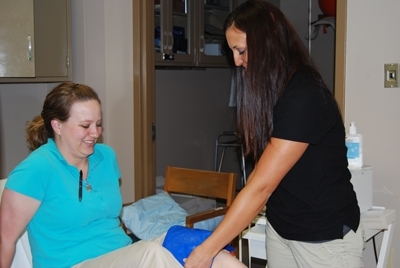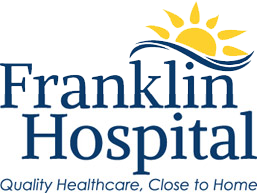201 Bailey Lane Benton, IL 62812
Franklin Hospital (618) 439-3161
Benton Walk-in Clinic (618) 435-9751
Christopher Walk-in Clinic (618) 435-9699
West Frankfort Walk-in Clinic (618) 932-2200
Therapy Services
From the moment you schedule your initial appointment, improving your quality of life is our priority!
Our goal is to provide comprehensive therapy services to improve your movement and function, and eliminate pain. We achieve this by employing individualized evidence-based exercise and treatment techniques customized to meet your therapy goals. Plans are developed by well-trained, experienced, licensed and specialty certified physical and occupational therapists. We are committed to providing professional excellence in a fun, casual environment.
Our rehabilitation services cover a broad range of conditions, including:
Sports injury
Muscle, tendon and ligament injury
Post-surgical rehabilitation
Back and neck pain/injury
Joint pain/injury
Arthritis
Amputations
We also provide neurological rehabilitation providing treatment for patients with a wide variety of conditions and diagnoses including:
Stroke
Brain injury
Spinal cord injury
Guillian-Barre Syndrome (muscle weakness and paralysis)
Parkinson's Disease (progressive disorder of the nervous system that affects movement)
Multiple Sclerosis (inflammatory disease in which the insulating covers of nerve cells in the brain and spinal cord are damaged)
Muscular Dystrophy (group of diseases that cause progressive weakness and loss of muscle mass)
Neuropathy (short for peripheral neuropathy, meaning nerve damage in the peripheral nervous system)
Other neurological injuries

Our Speech and Language pathologists are specially trained to address various impairments in adults and children. In children, early detection and treatment is vital to learning and communication. We provide comprehensive evaluation including testing, development and implementation of a treatment plan to meet you and your family's needs.
Speech and Language Therapy consists of assessment and treatment of any impairment related to speech, swallowing, language, and cognition. Whether the impairment is from trauma or from a disease process, rehabilitation of these impairments is critical to returning back to school or employment, successful swallowing, and independent communication.
Some common impairments addressed in speech and language therapy include:
Apraxia (motor disorder caused by damage to the brain)
Dysarthia (motor speech disorder resulting from neurological injury)
Stuttering
Aphesia (collection of language disorders caused by damage to the brain)
Orofacial disorders
Speech sound disorders

These impairments can be a result from:
Stroke
Traumatic brain injury
Oral and laryngeal cancer
Dementia
Neurological diseases
Language based learning disabilities
Preschool language and speech delays/disorders
Autism spectrum disorders
Cleft lip and palate
Other disorders of speech, voice, cognition and swallowing
Services we provide include:
Language and articulation evaluation and therapy
Swallowing assessment and therapy
Cognitive evaluation, treatment and retraining
Fluency evaluation and training
Pediatric evaluation and therapy
What to expect:
Prior to Initial VisitPrescription for treatment:
Most patients come to us with a prescription from physical therapy that was issued by their physician-this prescription is similar in form to what you take to the drugstore for medicine-and includes recommendations for treatment.
Insurance verification:
Our staff will verify your insurance and our participation in your specific insurance plan.
Initial Evaluation
What to wear:

We usually recommend that patients wear looser-fitting exercise clothing and sneakers for maximum comfort.
Patient registration forms:
Please arrive 10-15 minutes early to allow time to complete your patient registration forms. When you arrive at the Hospital, Rehab Receptionist will greet you and review the forms. The Receptionist will schedule all of your appointments and collect your co-payment (if applicable) at each visit.
Meet the therapist:
You will meet with a physical or occupational therapist, who will evaluate your injury or condition, discuss your goals and specific needs, and develop an individualized treatment plan.
Next steps:
The length of your treatment plan and frequency of visits is based on your specific injury/condition, the physician prescription, your insurance plan and the therapist's recommended treatment plan.
Regularly Scheduled Appointments
After each visit, you will work with a member of our clinical team who will instruct and supervise your care. As you reach specific treatment goals, you will progress to new levels, treatments and exercises.
At the end of each visit, your therapist will answer any questions you may have. This is a terrific time to share your thoughts, revisit your goals, and discuss any other pertinent information with your therapist.
In order for our clinical team to get you back to optimal functionality, in a quick and safe manner, you will likely have more than one therapy appointment per week. While this may present a temporary interruption to your schedule, your long-term gains will offset any inconvenience.
Home Exercise Programs
You may be provided with a home exercise program that compliments your plan of care. The home program is an important part of the healing process and will assist you in achieving your goals.
Communication
Your therapist will maintain regular contact with your doctor, surgeon and/or case manager to ensure timely updates on your progress.
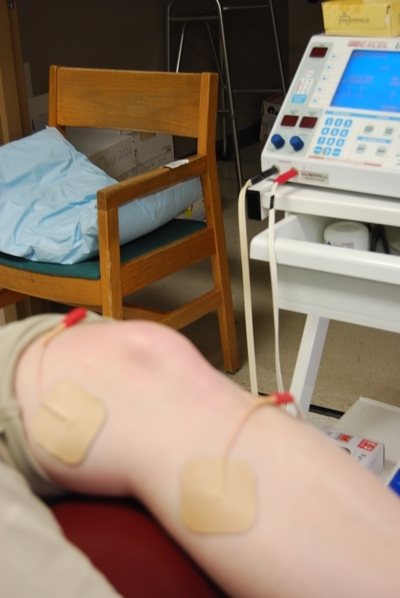 Electrical stimulation (or E stim) is used to increase localized blood flow to a patient’s leg in the Therapy Services department of Franklin Hospital. E stim can improve healing, reduce swelling and stimulate local nerve cells, which can have a pain reducing effect. E stim can also be used for the prevention of disuse muscle atrophy, which can occur, for example, after musculoskeletal injuries, such as damage to bones, joints, muscles, ligaments and tendons.
Electrical stimulation (or E stim) is used to increase localized blood flow to a patient’s leg in the Therapy Services department of Franklin Hospital. E stim can improve healing, reduce swelling and stimulate local nerve cells, which can have a pain reducing effect. E stim can also be used for the prevention of disuse muscle atrophy, which can occur, for example, after musculoskeletal injuries, such as damage to bones, joints, muscles, ligaments and tendons.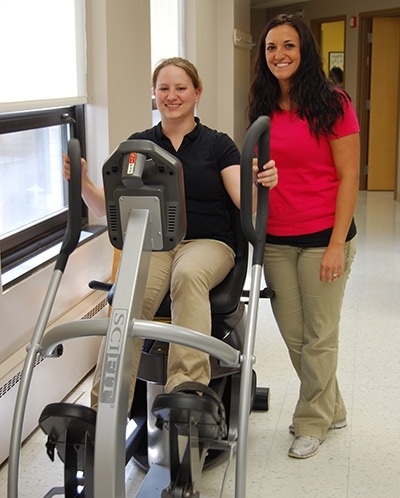 Courtney Lampley uses the Scifit total body elliptical trainer for total body exercise in Franklin Hospital Therapy Services Department.
Courtney Lampley uses the Scifit total body elliptical trainer for total body exercise in Franklin Hospital Therapy Services Department.
Smooth, elliptical movement for efficient total body exercise in both directions, provides knee-to-elbow core exercise. REX’s smooth, natural knee movement replicates climbing stairs to improve functional gait.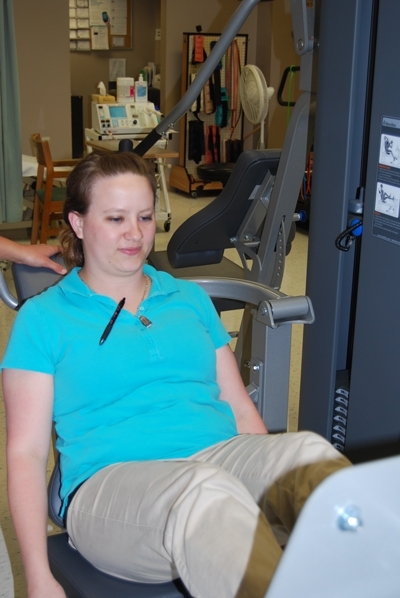 Courtney Lampley uses the Nautilus leg press in the Therapy Services Department to strengthen four major groups of leg muscles: quadriceps, hamstrings, gluteus maximums, and calves. This therapy is great for patients recovering from hip, knee, or ankle surgery.
Courtney Lampley uses the Nautilus leg press in the Therapy Services Department to strengthen four major groups of leg muscles: quadriceps, hamstrings, gluteus maximums, and calves. This therapy is great for patients recovering from hip, knee, or ankle surgery. Courtney Lampley uses the Nautilus shoulder press in the Therapy Services Department of Franklin Hospital to strengthen her deltoids and triceps, along with core muscles. This therapy is great for advanced patients recovering from rotator cuff surgery.
Courtney Lampley uses the Nautilus shoulder press in the Therapy Services Department of Franklin Hospital to strengthen her deltoids and triceps, along with core muscles. This therapy is great for advanced patients recovering from rotator cuff surgery.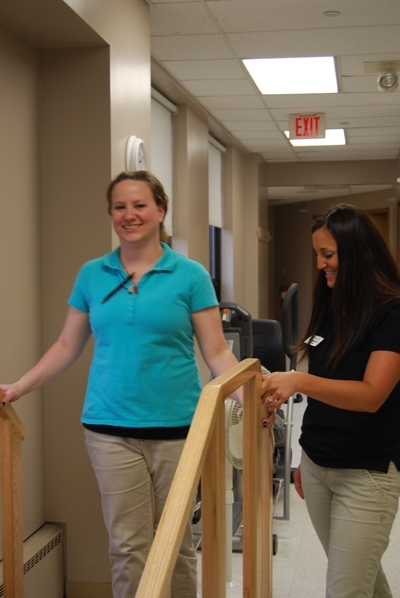 Courtney Lampley uses the stairs to improve her gait.
Courtney Lampley uses the stairs to improve her gait. Courtney Lampley receives ultrasound is a treatment modality commonly used to provide deep heating to soft tissues in the body. These include muscles, tendons, joints and ligaments.
Courtney Lampley receives ultrasound is a treatment modality commonly used to provide deep heating to soft tissues in the body. These include muscles, tendons, joints and ligaments.